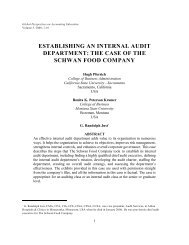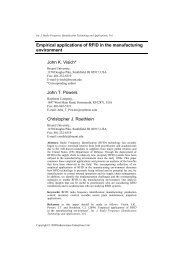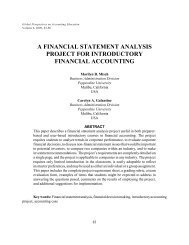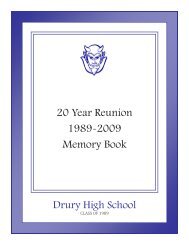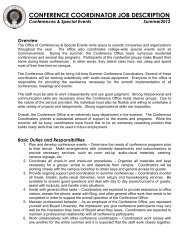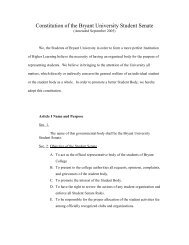Why use multiple-choice questions on accounting - Bryant
Why use multiple-choice questions on accounting - Bryant
Why use multiple-choice questions on accounting - Bryant
Create successful ePaper yourself
Turn your PDF publications into a flip-book with our unique Google optimized e-Paper software.
30 Simkin, Keuchler, Savage, and Stiverworld problems, or computati<strong>on</strong>al problems. In the discussi<strong>on</strong> that follows, the term “examinati<strong>on</strong>format” refers to the ratio of these two types of <str<strong>on</strong>g>questi<strong>on</strong>s</str<strong>on</strong>g> <strong>on</strong> a given certificati<strong>on</strong> examinati<strong>on</strong>.Table1 makes clear that the majority of <strong>accounting</strong> certificati<strong>on</strong> examinati<strong>on</strong>s rely heavily–orin most cases, solely–<strong>on</strong> <str<strong>on</strong>g>multiple</str<strong>on</strong>g> <str<strong>on</strong>g>choice</str<strong>on</strong>g> <str<strong>on</strong>g>questi<strong>on</strong>s</str<strong>on</strong>g>. The purpose of this article is to discuss theefficacy of using such <str<strong>on</strong>g>questi<strong>on</strong>s</str<strong>on</strong>g> to assess a test taker’s understanding of a given body of knowledge.The next secti<strong>on</strong> of this paper discusses the theoretical merits and drawbacks of usingsuch <str<strong>on</strong>g>questi<strong>on</strong>s</str<strong>on</strong>g> and reviews the empirical evidence. The third secti<strong>on</strong> reports the results of a newstudy that the authors c<strong>on</strong>ducted to empirically test the <str<strong>on</strong>g>use</str<strong>on</strong>g>fulness of MC <str<strong>on</strong>g>questi<strong>on</strong>s</str<strong>on</strong>g> as assessmentsof test taker knowledge. The fourth secti<strong>on</strong> provides further discussi<strong>on</strong> of our results and also somecaveats that limit our findings. The final secti<strong>on</strong> provides a summary and a set of c<strong>on</strong>clusi<strong>on</strong>s forour work.THE MC-CR CONTROVERSYLike tests in academia, the objective of most certificati<strong>on</strong> examinati<strong>on</strong>s is to assess acandidate’s knowledge in sufficient depth to assign a fair grade. Given the importance of manycertificati<strong>on</strong>s to both applicants and employers, a great deal rides <strong>on</strong> the efficiency and equity of theprocess. This, in turn, has led both scholars and certificati<strong>on</strong>-exam developers to ask “what type oftest format best performs this assessment task?”Assessment ChoicesMC examinati<strong>on</strong>s enjoy a number of important advantages. For example, they can be drawnrandomly from computerized test banks and administered frequently to test takers; they can begraded easily, quickly, c<strong>on</strong>sistently, and accurately; they are usually viewed as objective; they cancover a wide range of subjects; and they can be returned to their test takers in relatively short periodsof time (Zeidner, 1987; Snyder, 2003). These advantages probably account for the fact that, today,a host of professi<strong>on</strong>al certificati<strong>on</strong> examinati<strong>on</strong>s in such diverse disciplines as architecture, dentistry,engineering, law, medicine, optometry, pharmacology, computer programming, and veterinarysciences now <str<strong>on</strong>g>use</str<strong>on</strong>g> MC formats exclusively as assessment tools (Hamblen, 2006; Puliyenthuruthel,2005). Historically, the <strong>on</strong>e excepti<strong>on</strong> to this trend has been the AICPA exam, but 24 years ago,Mitchell Rothkopf, then director of the examinati<strong>on</strong> divisi<strong>on</strong>, argued str<strong>on</strong>gly for “no more essay<str<strong>on</strong>g>questi<strong>on</strong>s</str<strong>on</strong>g> <strong>on</strong> the uniform CPA exam” (Rothkopf, 1987).On the other hand, the most comm<strong>on</strong> argument favoring CR <str<strong>on</strong>g>questi<strong>on</strong>s</str<strong>on</strong>g> is the widespreadbelief that they test a deeper understanding of the subject material (Hwang et al., 2008; Ingram andHoward, 1998; Bridgeman, 1992; Lukhele et al.,1994). A related percepti<strong>on</strong> is that CR test <str<strong>on</strong>g>questi<strong>on</strong>s</str<strong>on</strong>g>are better at evaluating a resp<strong>on</strong>dent’s integrative skills–for example, beca<str<strong>on</strong>g>use</str<strong>on</strong>g> they demand amore–thorough grasp of the subject matter and its c<strong>on</strong>text–and therefore, better probe both thebreadth and depth of the test taker’s knowledge (Hancock, 1994; Rogers and Hartley, 1999; Bac<strong>on</strong>,2003). The fact that CR <str<strong>on</strong>g>questi<strong>on</strong>s</str<strong>on</strong>g> also test the resp<strong>on</strong>dent’s ability to organize thoughts into acohesive answer adds to this preference (Shaftel and Shaftel, 2007). It is probably for these reas<strong>on</strong>sthat some certificati<strong>on</strong> examinati<strong>on</strong>s in such areas as engineering or informati<strong>on</strong> technology nowhave extensive, performance-based comp<strong>on</strong>ents. Similarly, essay <str<strong>on</strong>g>questi<strong>on</strong>s</str<strong>on</strong>g> have been re-introducedinto the SAT examinati<strong>on</strong>s beca<str<strong>on</strong>g>use</str<strong>on</strong>g> its administrators felt that such <str<strong>on</strong>g>questi<strong>on</strong>s</str<strong>on</strong>g> better assess theaccuracy of language and reas<strong>on</strong>ing skills (Katz et al., 2000).Professi<strong>on</strong>al accountants do not answer test <str<strong>on</strong>g>questi<strong>on</strong>s</str<strong>on</strong>g> for a living. Rather, they perform<strong>accounting</strong> tasks using the skills they have learned in school or acquired at work. Thus, a final


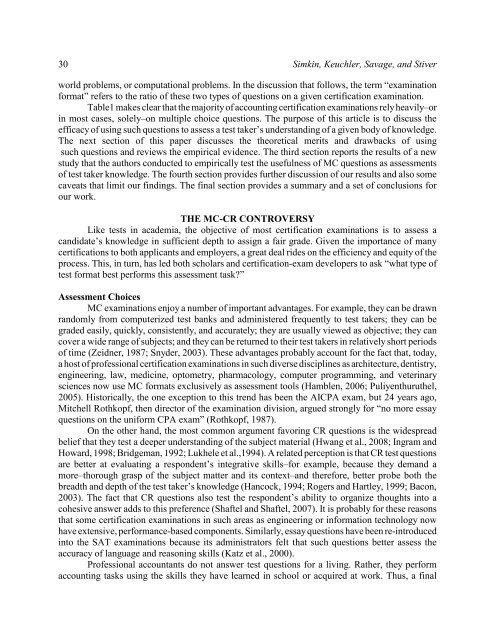
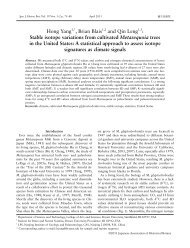
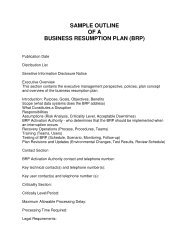
![[1] The Legal Environment of Business (LGLS211) Andrea Boggio ...](https://img.yumpu.com/45269009/1/190x245/1-the-legal-environment-of-business-lgls211-andrea-boggio-.jpg?quality=85)
